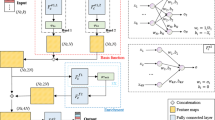Abstract
The formulation, implementation and performance of a new fully implicit parallel model of the ocean circulation is presented. Within this model, steady states can be traced in one of the control parameters. In addition, transient flows can be computed using relatively (compared to traditional ocean models) large time steps such that long integration times can be reached. The discretized equations of the ocean model are solved by the Newton-Raphson technique and the emerging linear systems are solved by a (MPI) version of the MUltifrontal Massively Parallel Solver. The performance of the code on an SGI Origin 2000 platform is presented here using typical results for a sector ocean flow.
Similar content being viewed by others
References
P. Amestoy, I. Duff, and J.-Y. L'Excellent. MUMPS MUltifrontal Massively Parallel Solver, Version 2.0. Technical Report TR/PA/98/02. CERFACS, 42 Ave G. Coriolis, 31057 Toulouse Cedex, France, 1998.
W. S. Broecker. The great ocean conveyor. Oceanography, 4: 79–89, 1991.
H. A. Dijkstra, M. J. Molemaker, A. van der Ploeg, and E. F. F. Botta. An efficient code to compute nonparallel flows and their linear stability. Comp. Fluids, 24: 415–434, 1995.
H. A. Dijkstra, H. Oksuzoglu, F. W. Wubs, and E. F. F. Botta. A fully implicit model of the three-dimensional thermohaline ocean circulation. J. Comp. Physics, 176: 685–715, 2001.
I. S. Duff, E. Erisman, and J. K. Reid. Direct Methods for Sparse Matrices, Clarendon Press, Oxford, U.K., 1986.
S. Frickenhaus. Overview of parallel sparse solvers. www.awi-bremerhaven.de/InfoCenter/IT/WorkingGroups/SciComp/SSolversUG.html, 2000.
A. Gupta, F. Gustavson, M. Joshi, G. Karypis, and V. Kumar. PSPASES: An efficient and scalable parallel sparse direct solver. www-users.cs.umn.edu/mjoshi/pspases/, 1999.
R. L. Haney. Surface thermal boundary conditions for ocean circulation models. J. Phys. Oceanography, 4: 241–248, 1971.
H. B. Keller. Numerical solution of bifurcation andnonlinear eigenvalue problems. In P. H. Rabinowitz, ed., Applications of Bifurcation Theory, pp. 359–384. Academic Press, New York, 1977.
S. Manabe and R. J. Stouffer. Century-scale effects of increased CO2 on the ocean-atmosphere system. Nature, 364: 215–220, 1993.
J. Pedlosky. Geophysical Fluid Dynamics, pp. 315–325. Springer-Verlag, New York, 1987.
R. Peyret and T. S Taylor. Computational Methods for Fluid Flow. Springer, New York, 1983.
F. L. Yin and E. S. Sarachik. An efficient convective adjustment scheme for ocean general circulation models. J. Phys. Oceanography, 24: 1425–1430, 1994.
Author information
Authors and Affiliations
Rights and permissions
About this article
Cite this article
de Kloe, J., van der Steen, A., Öksüzoğlu, H. et al. A Fully Implicit Parallel Ocean Model Using MUMPS. J Supercomput 23, 167–183 (2002). https://doi.org/10.1023/A:1016548411878
Issue Date:
DOI: https://doi.org/10.1023/A:1016548411878




